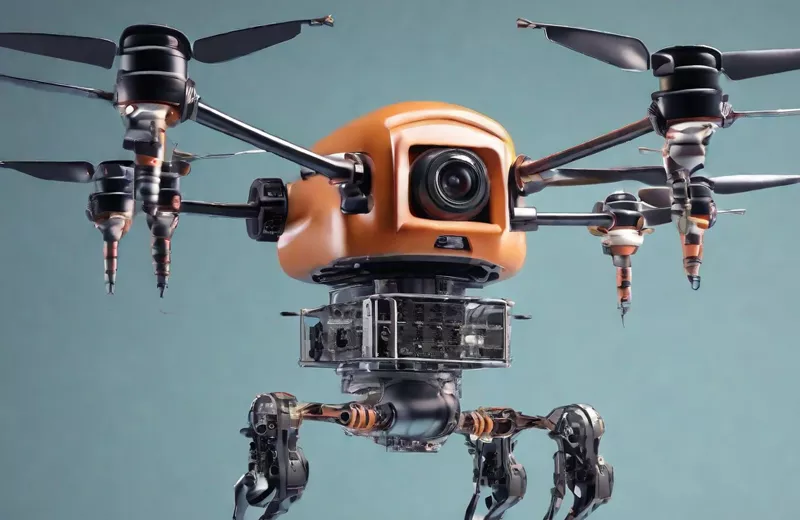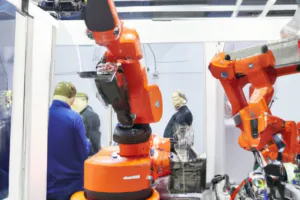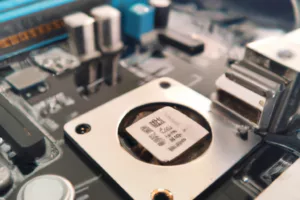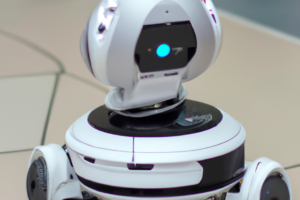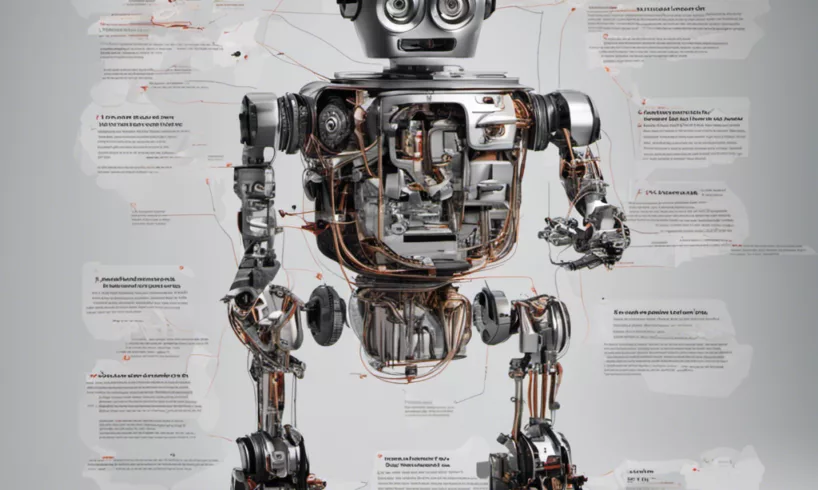
Introduction To The Anatomy of a Robot
Robots have become an integral part of our everyday lives. From manufacturing products to performing surgeries, robots are being used in a variety of applications across many different industries. While early robots were primitive machines, modern robots are highly sophisticated systems seamlessly integrating hardware and software components.
Many different types of robots are used today, ranging from industrial robots used in automotive assembly plants to social companion robots designed to interact with humans. Some common categories of robots include:
- Industrial robots: Used for tasks like welding, painting, and assembly in manufacturing environments. These are usually giant, stationary robots mounted in place to perform repetitive tasks.
- Service robots: Used to help humans by performing tasks like cleaning and delivery. Roombas and delivery drones are examples of service robots.
- Social robots are designed to interact with people through speech, gestures, and facial expressions. Social robots may provide information, companionship, or entertainment.
- Mobile robots: Capable of autonomous movement thanks to motors and sensors. Mobile robots can navigate environments on wheels, tracks, or legs.
- Humanoid robots: Designed with a human-like torso, arms, and head. They mimic the movements and capabilities of humans.
The use of robots offers many benefits, including:
- Increased productivity and efficiency
- Consistent quality and precision
- Ability to automate dangerous or repetitive tasks
- Operation in hazardous environments
- More free time for human workers
- New applications like robotic surgery and space exploration
As robots advance in capabilities, they will become an even more crucial part of our everyday lives. Understanding how these amazing machines work helps illuminate the technological marvels that make them possible.
Robot Anatomy: The Essential Components
Like animals and humans, robots have specialized components that work together to give them life and functionality. These core anatomical systems give robots their unique capabilities:
End Effectors: The Robot's “Hands”
End effectors are the robot equivalent of human hands. Located at the end of a robotic arm, end effectors allow robots to interact with their environment by grasping, moving, and manipulating objects.
Common types of end effectors include:
- Grippers: Pinchers, jaws, or clamps that grab and hold objects. Industrial grippers come in a range of designs optimized for different purposes.
- Tools: Devices like drill bits, grinders, or welding torches that perform work on objects. The “hand” changes tools to fit the task.
- Suction cups: Used to pick up objects via vacuum suction. Ideal for smooth, flat surfaces.
- Magnets: Enable robots to temporarily adhere to and pick up magnetic objects like metal sheets.
End effectors are designed to be easily interchangeable, allowing the same robot to perform multiple functions. Precise movement and integration with sensors give end effectors the skill to conduct delicate operations.
Actuators: Robot Muscle
Actuators are the mechanisms that cause motion in robots. They act as the “muscles” that mobilize joints and limbs. Different types of actuators include:
- Electric motors: Spinning motors convert electrical energy into mechanical torque and movement. Highly efficient and controllable.
- Hydraulic actuators: Use pressurized hydraulic fluid to generate linear motion and force. They are commonly used in heavy-lifting applications.
- Pneumatic actuators: Use compressed air to move to cylindrical chambers. Quick and powerful.
- Piezoelectric actuators: Use crystal materials that change shape when voltage is applied. Enable ultra-precise movements.
- Shape memory alloys: Metals that change form based on temperature. They are used for robotic limbs that need to bend.
Actuators allow robots to turn wheels, raise arms, grip objects, and mimic other motions. Multiple actuators coordinated by a control system enable complex robotic movements.
Sensors: The Robot's Perception
Sensors give robots vital perception and awareness of their environment. Feedback from sensors is used to determine robotic actions and behaviors. Robots may use a variety of internal and external sensors, including:
- Proximity sensors: Detect nearby objects without physical contact. Help robots avoid collisions.
- Vision systems: Cameras and image processing algorithms that enable visual perception. Allow robots to “see.”
- Tactile sensors: Sense touch, pressure, and grip on contact surfaces. Provide feedback for precise movements.
- Accelerometers: Measure changes in motion, tilt, and orientation. Essential for balancing and maneuvering.
- GPS sensors: Provide location and positioning data via satellite. They are used in applications like self-driving vehicles.
- Thermal sensors: Detect heat sources and temperature changes in the environment. Useful for navigation and hazard detection.
- Noise sensors: Detect sound cues that inform robot reactions. It may allow response to voice commands.
Advances in sensor technology continue to improve the perception capabilities of modern robots. Integrating a variety of sensor inputs allows robots to form a detailed representation of their surroundings.
Controllers: The Robot's “Brain”
The controller acts as the robot's computer “brain,” coordinating all of the inputs from sensors and triggering actions by actuators and end effectors. It executes the programming that determines how the robot will behave.
Several types of controllers are used in robots:
- Microcontrollers: Miniature computers-on-a-chip that control electronics and simple robots.
- PLCs (programmable logic controllers): Rugged industrial computers used for automation tasks.
- Neural networks: Systems modeled after the human brain that can learn and make decisions.
- Robot operating systems: Software frameworks that manage core robot functions.
The complexity of the controller matches the capabilities of the robot. Advanced robots like self-driving cars use AI and neural networks for decision-making, while simple industrial robots may just run pre-programmed sequences. The controller ties everything together to make the robot functional.
Power Sources: Energizing the Robot
Robots require power sources to activate their electrical and mechanical systems. Small robots may use batteries, while giant industrial robots tap into AC power grids. Other energy sources include:
- Gas engines: Small gasoline engines provide mobile power for some outdoor robots.
- Hydraulic power: Fluid pressure from pumps drives hydraulic limb movements.
- Pneumatic power: Compressed air fed via hoses power air-driven actuators.
- Solar power: Solar panels can recharge batteries, especially for outdoor robots.
Having adequate electrical power enables robots to operate for extended periods without human intervention. Some robots can even seek out power sources when battery levels are low.
By combining all of these core anatomical systems – end effectors, actuators, sensors, controllers, and power sources – robots obtain their signature capabilities to sense, process, and interact with the world around them. Technological improvements will enable robots to become even more wise, intelligent and valuable.
Robot Locomotion: Moving Through the World
For robots to fully harness their abilities, they need efficient mobility methods to travel through their environments. Robots have adopted a variety of locomotion strategies:
Wheeled Robots: Steady and Swift Movement
Wheels are one of the most common locomotion methods used in robotics. Types of wheeled robots include:
- Two-wheel balancing robots: Balance on two wheels by angling rotation to stay upright as they roll.
- Differential drive robots: Controlled by two separately driven wheels on either side. Allows tight turns and spin maneuvering.
- Synchronous drive robots: Wheels on both sides turn in unison, achieving simple forward/backward motion. Very stable.
- Mecanum wheel robots: Wheels with angled rollers that move robots in any direction. Provides optimal maneuverability.
Wheels offer efficient, speedy movement and simplified steering control. However, they perform best only on flat, smooth surfaces. Wheeled robots can struggle with stairs and rough natural terrain.
Legged Robots: Stepping Over Obstacles
Robots on legs can more nimbly traverse obstacles and uneven ground compared to wheeled bots. Different types of legged robots include:
- Bipedal (2 legs): Allow human-like walking and movement. Achieving balance and mimicry of human gaits is complex.
- Quadrupedal (4 legs): More stable with 4 points of contact. It directly mimics animal movement.
- Hexapod (6 legs): A standard form for insect-inspired robots. It provides stability while keeping motion smooth.
- Many-legged: “Millipede” style bots with dozens of short legs. Very slow but can handle uneven terrain.
Legs expand mobility over steps, gaps, rubble, and other obstacles. However, controlling legged robots to achieve reliable, human-like gaits remains an ongoing research challenge, especially for bipedal designs.
Aerial Robots: Unconstrained Flight
Aerial robots overcome physical barriers by taking to the skies. Quadcopters, hexacopters, and other multirotor drones are now widely used for photography, inspections, and more. Fixed-wing drones provide faster and more prolonged duration flight. Other aerial robots include:
- Helicopters: Achieve vertical takeoff and landing using one or more rotor blades. Allow hovering and directional flight.
- Blimps/Balloons: Use buoyant gas or heated air to float. Can remain semi-stationary in midair for long periods.
- Ornithopters: Flapping wing robots that mimic bird flight mechanics. Require complex joint actuators.
Untethered flight gives aerial robots unique perspectives and access to hazardous situations like damaged buildings or industrial accidents. However, limitations on battery life, weather sensitivity, and flight stability remain ongoing challenges.
Robot Control Systems: Directing the Machine
Once a robot has sensing capabilities and the ability to move through its environment, it needs intelligent control systems to dictate its behaviors and actions:
Manual Control: Piloting by Human Operators
The most straightforward way to control a robot is by direct human operation:
- Teleoperation: A human pilot controls the robot remotely using handheld controllers, joysticks, or other manual input devices. They are used extensively for drone flight.
- Exoskeletons: A human wears a powered mechanical suit that moves when the wearer moves. The human operates the robot like their own body.
- Suites: A robot is controlled by a human passenger riding inside its body. It is common in mechs and other sci-fi robots.
Manual control allows direct human oversight over robot actions. However, it requires constant human attention and limits the robot's autonomy. It works best for well-defined tasks in controlled environments.
Programmed Control: Following Coded Instructions
For robots that perform repetitive or predictable tasks, pre-programmed control is a practical approach:
- Teaching by demonstration: A human shows the robot how to perform a task, and programming records those movements for later repetition.
- Scripting: Sequences of stored commands are executed, allowing the creation of complex robotic procedures.
- Offline CAD programming: Robot motions are simulated and optimized virtually through CAD software before deployment.
Pre-programmed control enables autonomous operation and consistency once deployed. However, it offers little flexibility – any new situations or environmental changes require reprogramming.
Autonomous Control: Adaptable Decision Making
Cutting-edge robots are gaining the ability to make their own decisions:
- AI and machine learning: Artificial intelligence systems enable robots to learn from data and experiences rather than just following programmed rules.
- Neural networks: Networks modeled after animal brains allow robots to recognize patterns and make judgment calls.
- Computer vision: Cameras and image recognition algorithms enable robots to identify objects and navigate obstacles.
- Edge computing: Putting local computing right on robots allows faster processing and decisions than relying on the cloud.
Autonomous capabilities allow next-generation robots to adapt to changing conditions in real time without human guidance. This allows operation in complex environments like city streets and human interaction spaces. However, these systems raise concerns about safety, security, and ethics without human oversight.
Robot Applications: Serving Across Industries
Versatile robots are being deployed across a growing spectrum of applications:
Manufacturing: Automating Processes
Manufacturing was one of the first industries to benefit from robotics:
- Assembly: Robots excel at efficiently assembling products with precision and consistency.
- Material handling: Robots transport materials and finished products between factory workstations.
- Welding: Automated welding by industrial robots improves speed and quality.
- Painting and finishing: Robots apply paint and finishes uniformly to achieve consistent coatings.
- Palletizing: Robots stack and arrange boxes and materials into pallets for storage and shipping.
By automating repetitive, dangerous assembly line tasks, manufacturing robots can increase productivity and end-product quality. They also reduce physical strain for human workers.
Logistics: Optimizing Storage and Delivery
Robots are transforming warehouse and logistics operations:
- Pick and place: Robots autonomously identify, grab, and move inventory items for order fulfillment.
- Inventory scanning: Mobile bots with cameras scan shelves to monitor inventory levels and items.
- Automated storage and retrieval: Robots automatically store and retrieve items from densely packed shelves.
- Last mile delivery: Robots handle local delivery of packages via road or aerial transport.
Logistics automation allows scaling order fulfillment to meet rising consumer demand. It enables companies to maximize warehouse storage density. Robots also reduce order processing times.
Healthcare: Improving Care
From surgeries to disinfection, healthcare is utilizing robotics in new ways:
- Robotic surgery: Robots allow remote-controlled, minimally-invasive surgery with greater precision and flexibility.
- Prosthetics: Robotic limbs and exoskeletons restore mobility and improve the quality of life for many patients.
- Disinfection: UV light and other robots help thoroughly sanitize hospital rooms, reducing healthcare-acquired infections.
- Physical therapy: Robots guide rehabilitation exercises and quantify patient progress through motion tracking.
- Companionship: Social robots provide cognitive stimulation, reminders, and social contact for long-term care residents.
Healthcare robots enhance the accuracy and accessibility of treatment while minimizing infection risks. Continued adoption can help improve patient outcomes and experiences.
Customer Service: Enhancing Experiences
Robots are entering retail, hospitality, and other customer-facing settings:
- Receptionists: Robot greeters welcome visitors to businesses and venues while providing helpful information.
- Retail assistants: Store robots can scan shelves, point shoppers to items, and answer product questions.
- Foodservice: Robotic arms can rapidly prepare customized drinks and food items in busy cafes and restaurants.
- Hotel attendants: Service robots deliver amenities, provide concierge services, and handle hotel cleaning tasks.
- Entertainment: Animatronic robots provide amusement park attractions, interactive museum exhibits, and other entertainment experiences.
Service robots allow businesses to provide consistent, personalized interactions with large volumes of customers. They also present unique opportunities for engagement and education.
The Future of Robotics
Robots have become integral to our modern human experience. As their anatomy and capabilities evolve, robots will work more closely alongside humans while spreading into new environments.
Ongoing robotics research focuses on improvements like:
- More adaptable, compliant limbs with smooth and precise movement
- Tactile skin sensors to replicate human touch sensitivity
- Object and speech recognition for natural communication
- Lightweight materials to improve mobility efficiency
- Cloud connectivity and AI to share experiences between robots
These innovations will enable robots to take on more ambiguous, complex tasks while operating safely and naturally around humans. Expansion into agriculture, construction, mining, and other hazardous fields could significantly improve safety and productivity.
However, the rise of intelligent, autonomous robots also surfaces significant ethical concerns:
- Potential job displacement of human workers
- Accountability for robot actions and mistakes
- Security vulnerabilities from hacking
- Development of common sense reasoning in AI
- Transparency in data collection and usage
Solving these challenges will require technical and policy innovations alongside societal conversations about integrating these rapidly advancing technologies.
By understanding the anatomical fundamentals of how robots function, we gain perspective into how they will reshape our society. The anatomy of robots holds exciting promise to extend human capabilities to new frontiers.

George Smith, with over a decade in tech journalism, excels in breaking down emerging tech trends. His work, spanning tech blogs and print, combines in-depth analysis with clarity, appealing to a wide readership. George's pieces often explore technology's societal impact, showcasing his foresight in industry trends.


